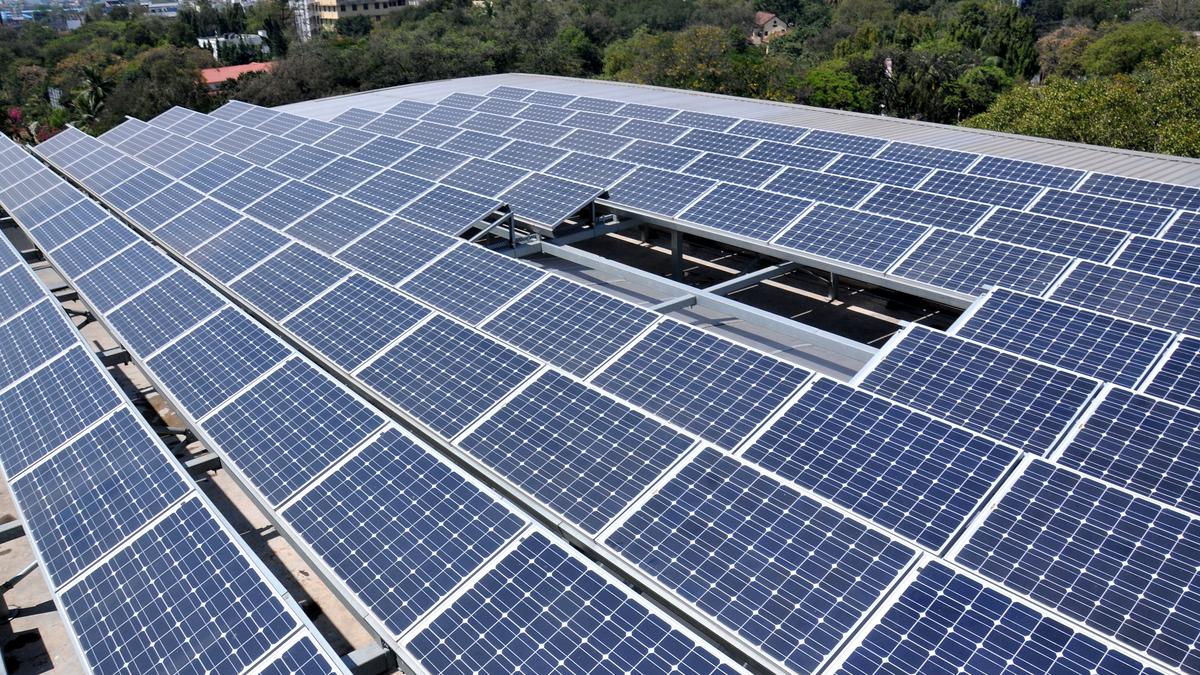India to be net exporter of solar modules by 2026, says Ministry for New and Renewable Energy official

Representational file image.
| Photo Credit: Nagara Gopal
By 2026, Indian industry will be able to manufacture solar modules worth 100 gigawatts (GW) annually, and help the country be a net exporter of solar power. This would significantly aid India’s target of installing 500 GW of electricity capacity from non-fossil sources by 2030, Bhupinder Bhalla, Secretary, Ministry for New and Renewable Energy, told The Hindu.
India was to have installed 175 GW of renewable energy — from solar, wind, biomass and small hydropower sources — by December 2022 but has only installed 122 GW. Of this, solar power was to have been 100 GW though only 62 GW has been installed. A key bottleneck has been the cost of solar modules (or panels). While India has traditionally relied on China-made components such as poly-silicone wafers, necessary to make modules, higher customs duty on them (to make equivalent India-manufactured components more competitive) has shrunk supply.
“We’ll need about 30-40 GW for our domestic purposes annually and the rest can be used for export. The incentive schemes that are in place are designed to encourage the manufacturers of wafers. We have never had polysilicone manufacturing in India and this is the first time we’ll be making ingots and wafers in India. This is necessary for the future health of the solar ecosystem in India,” Mr. Bhalla told The Hindu in an exclusive interaction.
Apart from module prices, land acquisition has been a major challenge for solar power manufacturers. Despite the Centre commissioning 57 large solar parks worth 40 GW in recent years, only 10 GW have been operationalised. “Installing a megawatt of solar power requires on average four acres of land. So various developers face challenges in acquiring it and that’s one reason for the delay. Some projects have been cancelled, for lack of progress, but we expect 40 GW to be fully commissioned in the next two years,” Mr. Bhalla said.
The future phase of India’s renewable energy development will be led by hybrid projects and renewable energy parks that will host solar and wind projects along with battery storage systems. “States have been demanding consistent, dependable power and that can be done only if solar and wind power is stored [via batteries] and made available on demand. This is, of course, a challenge globally,” he said.
The travails of the Adani Group of Companies, several of which had announced investments in solar and green hydrogen infrastructure, wouldn’t significantly impact India’s long-term renewable energy goals. “While the Adani Group and their commitments to renewable energy are certainly significant, we have multiple other companies that can step in. There is tremendous interest in India by sovereign wealth funds and other investors and so I don’t see any impact on our renewable energy plans,” Mr. Bhalla said.
He added that the Pradhan Mantri Kisan Urja Suraksha evam Uttham Mahabhiyan (PM KUSUM) scheme, which aims to help farmers access reliable day-time solar power for irrigation, reduce power subsidies, and thereby decarbonises agriculture, was behind schedule because of the “high cost of finance” for farmers.
Under the scheme, ₹34,422 crore is to be spent by the Centre to have farmers or farmer groups install solar power plants worth 10,000 MW, installation of 20 lakh solar-powered agriculture pumps that aren’t connected to the grid (off-grid), and converting 15 lakh agriculture pumps that are already connected to the grid into solar-powered pumps.
As of December 31, 2022 only 88.46 MW of solar capacity had been added, 181,058 solar pumps had been installed, and 1,174 grid-connected pumps had been converted. The deadline for the scheme has been shifted to 2026. “We are looking at ways to help farmers access loans from bank at cheaper rates to encourage adoption,” Mr. Bhalla said.
For all the latest business News Click Here

